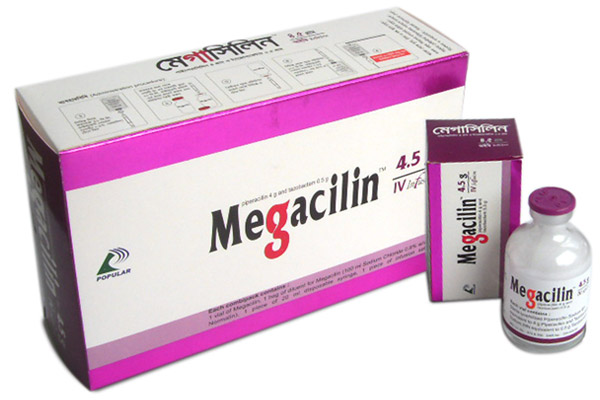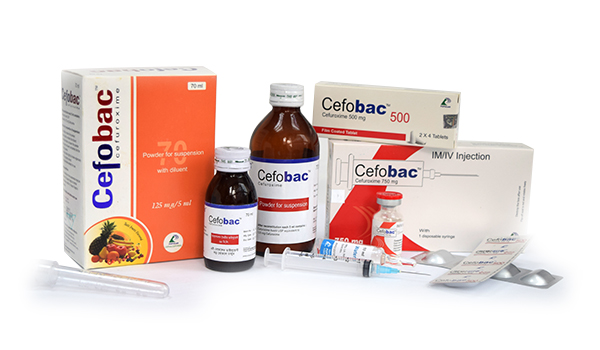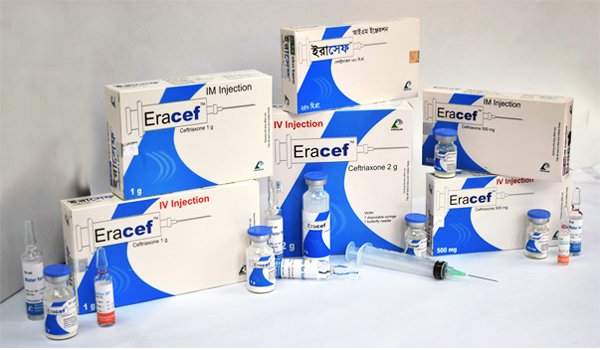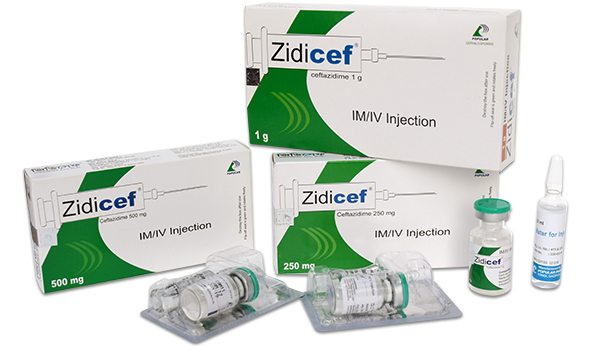Indication
Piperacillin and tazobactam is indicated for the treatment of patients with moderate to severe infections caused by piperacillin-resistant, piperacillin/tazobactam susceptible, --lactamase producing strains of the designated microorganisms in the specified conditions listed below:
Appendicitis (complicated by rupture or abscess) and peritonitis caused by piperacillin-resistant, --lactamase producing strains of Escherichia coli or the following members of the Bacteroides fragilis group: B. fragilis, B. ovatus, B. thetaiotaomicron, or B. vulgatus.
Uncomplicated and complicated skin and skin structure infections, including cellulitis, cutaneous abscesses and ischemic/diabetic foot infections caused by piperacillin-resistant, --lactamase producing strains of Staphylococcus aureus.
Postpartum endometritis or pelvic inflammatory disease caused by piperacillin-resistant, --lactamase producing strains of Escherichia coli.
Community-acquired pneumonia (moderate severity only) caused by piperacillin-resistant, --lactamase producing strains of Haemophilus influenzae.
Nosocomial pneumonia (moderate to severe) caused by piperacillin-resistant, --lactamase producing strains of Staphylococcus aureus and by piperacillin/tazobactam-susceptible Acinetobacter baumanii, Haemophilus influenzae, Klebsiella pneumoniae, and Pseudomonas aeruginosa (Nosocomial pneumonia caused by P. aeruginosa should be treated in combination with an aminoglycoside).
Piperacillin and tazobactam for IV infusion is indicated only for the specified conditions listed above. Infections caused by piperacillin-susceptible organisms, for which piperacillin has been shown to be effective, are also amenable to Megacilin treatment due to its piperacillin content. The tazobactam component of this combination product does not decrease the activity of the piperacillin component against piperacillin-susceptible organisms. Therefore, the treatment of mixed infections caused by piperacillin-susceptible organisms and piperacillin-resistant, --lactamase producing organisms susceptible to piperacillin and tazobactam should not require the addition of another antibiotic. Megacilin is useful as presumptive therapy in the indicated conditions prior to the identification of causative organisms because of its broad spectrum of bactericidal activity against gram-positive and gram-negative aerobic and anaerobic organisms.
Microbiology
Piperacillin exerts bactericidal activity by inhibiting septum formation and cell wall synthesis of susceptible bacteria. In vitro, piperacillin is active against a variety of gram-positive and gram-negative aerobic and anaerobic bacteria.
It is, however, a --lactamase inhibitor of the Richmond-Sykes class III (Bush class 2b & 2b') penicillinases and cephalosporinases. It varies in its ability to inhibit class II and IV (2a & 4) penicillinases. Tazobactam does not induce chromosomally-mediated --lactamases at tazobactam concentrations achieved with the recommended dosage regimen. Piperacillin/tazobactam has been shown to be active against most strains of the following microorganisms both in vitro and in clinical infections.
Aerobic and facultative Gram-positive microorganisms:
Staphylococcus aureus (excluding methicillin and oxacillin-resistant isolates)
Aerobic and facultative Gram-negative microorganisms:
Acinetobacter baumanii, Escherichia coli, Haemophilus influenzae (excluding --lactamase negative, ampicillin-resistant isolates), Klebsiella pneumoniae, Pseudomonas aeruginosa (given in combination with an aminoglycoside to which the isolate is susceptible)
Gram-negative anaerobes:
Bacteroides fragilis group (B. fragilis, B. ovatus, B. thetaiotaomicron, and B. vulgatus)
Aerobic and facultative Gram-positive microorganisms:
Enterococcus faecalis (ampicillin or penicillin-susceptible isolates only), Staphylococcus epidermidis (excluding methicillin and oxacillin-resistant isolates), Streptococcus agalactiae †, Streptococcus pneumoniae†(penicillin-susceptible isolates only), Streptococcus pyogenes †, Viridans group streptococci â€
Aerobic and facultative Gram-negative microorganisms:
Citrobacter koseri, Moraxella catarrhalis, Morganella morganii, Neisseria gonorrhoeae, Proteus mirabilis, Proteus vulgaris, Serratia marcescens, Providencia stuartii, Providencia rettgeri, Salmonella enterica
Gram-positive anaerobes:
Clostridium perfringens Gram-negative anaerobes: Bacteroides distasonis, Prevotella melaninogenica
†These are not --lactamase producing bacteria and, therefore, are susceptible to piperacillin alone.
Dosage & Administration
Piperacillin and tazobactam should be administered by intravenous infusion over 30 minutes. The usual total daily dose of Piperacillin and tazobactam for adults is 3.375 g every six hours totaling 13.5 g (12.0 g piperacillin/1.5 g tazobactam).
Nosocomial Pneumonia :
Initial presumptive treatment of patients with nosocomial pneumonia should start with piperacillin and tazobactam at a dosage of 4.5 g every six hours plus an aminoglycoside, totaling 18.0 g (16.0 g piperacillin/2.0 g tazobactam). Treatment with the aminoglycoside should be continued in patients from whom Pseudomonas aeruginosa is isolated. If Pseudomonas aeruginosa is not isolated, the aminoglycoside may be discontinued at the discretion of the treating physician. Due to the in vitro inactivation of the aminoglycoside by beta-lactam antibiotics, piperacillin and tazobactam and the aminoglycoside are recommended for separate administration. piperacillin and tazobactam and the aminoglycoside should be reconstituted, diluted, and administered separately when concomitant therapy with aminoglycosides is indicated.
Renal Insufficiency :
In patients with renal insufficiency (Creatinine Clearance > 40 mL/min), the intravenous dose of Megacilin (piperacillin and tazobactam for IV infusion) should be adjusted to the degree of actual renal function impairment. In patients with nosocomial pneumonia receiving concomitant aminoglycoside therapy, the aminoglycoside dosage should be adjusted according to the recommendations of the manufacturer. The recommended daily doses of Piperacillin and tazobactam for patients with renal insufficiency are as follows:
| Renal Function (Creatinine Clearance,mL/min) | All Indications (except noncominal pneumonia) | Nosocomial Pneumonia | ||
|
>40 ml/min 20-40 ml/min* <20 ml/min* Hemodialysis** CAPD |
|
3.375 g 6 h 2.25 g 6 h 2.25 g 8 h 2.25 g 12 h 2.25 g 12 h |
|
4.5 g 6 h 3.375 g 6 h 2.25 g 6 h 2.25 g 8 h 2.25 g 8 h |
- Creatinine clearance for patients not receiving hemodialysis
- 75 g should be administered following each hemodialysis session on hemodialysis days for patients on hemodialysis, the maximum dose is 2.25 g every twelve hours for all indications other than nosocomial pneumonia and 2.25 g every eight hours for nosocomial pneumonia. Since hemodialysis removes 30% to 40% of the administered dose, an additional dose of 0.75 g piperacillin and tazobactam should be administered following each dialysis period on hemodialysis days. No additional dosage of piperacillin and tazobactam is necessary for CAPD patients.
Duration of Therapy :
The usual duration of piperacillin and tazobactam treatment is from seven to ten days. However, the recommended duration of piperacillin and tazobactam treatment of nosocomial pneumonia is 7 to 14 days. In all conditions, the duration of therapy should be guided by the severity of the infection and the patient's clinical and bacteriological progress.
Hepatic Insufficiency :
The half-life of piperacillin and of tazobactam increases by approximately 25% and 18%, respectively, in patients with hepatic cirrhosis compared to healthy subjects. However, this difference does not warrant dosage adjustment of piperacillin and tazobactam due to hepatic cirrhosis.
Precautions
Bleeding manifestations have occurred in some patients receiving --lactam antibiotics, including piperacillin. These reactions have sometimes been associated with abnormalities of coagulation tests such as clotting time, platelet aggregation and prothrombin time, and are more likely to occur in patients with renal failure. If bleeding manifestations occur, piperacillin and tazobactam for IV infusion should be
discontinued and appropriate therapy instituted. The ossibility of the emergence of resistant organisms that might cause superinfections should be kept in mind. If this occurs, appropriate measures should be taken. As with other penicillins, patients may experience neuromuscular excitability or convulsions if higher than recommended doses are given intravenously (particularly in the presence of renal failure). piperacillin and tazobactam contains a total of 2.79 mEq (64 mg) of Na+ per gram of piperacillin in the combination product. This should be considered when treating patients requiring restricted salt intake. Periodic electrolyte determinations should be performed in patients with low potassium reserves, and the possibility of hypokalemia should be kept in mind with patients who have potentially low potassium reserves and who are receiving cytotoxic therapy or diuretics. As with other semisynthetic penicillins, piperacillin therapy has been associated with an increased incidence of fever and rash in cystic fibrosis patients. In patients with creatinine clearance > 40 mL/min and dialysis patients (hemodialysis and CAPD), the intravenous dose should be adjusted to the degree of renal function impairment.
Pediatric Use :
Use of piperacillin and tazobactam in pediatric patients 2 months of age or older with appendicitis and/or peritonitis is supported by evidence from well-controlled studies and pharmacokinetic studies in adults and in pediatric patients. Safety and efficacy in pediatric patients less than 2 months of age have not been established. There are no dosage recommendations for piperacillin and tazobactam in pediatric patients with impaired renal function.
Geriatric Use :
Patients over 65 years are not at an increased risk of developing adverse effects solely because of age. However, dosage should be adjusted in the presence of renal insufficiency. In general, dose selection for an elderly patient should be cautious, usually starting at the low end of the dosing range, reflecting the greater frequency of decreased hepatic, renal, or cardiac function, and of concomitant disease or other drug therapy.
Use in Pregnancy :
Pregnancy Category B. Piperacillin and tazobactam cross the placenta in humans.
Use in Lactation :
Piperacillin is excreted in low concentrations in human milk; tazobactam concentrations in human milk have not been studied. Caution should be exercised when piperacillin and tazobactam for IV infusion is administered to a nursing woman.
Warnings :
Serious anaphylactic/anaphylactoid reactions (including shock) require immediate emergency treatment with epinephrine. Oxygen, intravenous steroids, and airway management, including intubation, should also be administered as indicated. Clostridium difficile associated diarrhea (CDAD) has been reported with use of nearly all antibacterial agents, including piperacillin and tazobactam and may range in severity from mild diarrhea to fatal colitis. Treatment with antibacterial agents alters the normal flora of the colon leading to overgrowth of C. difficile. If CDAD is suspected or confirmed, ongoing antibiotic use not directed against C. difficile may need to be discontinued. Appropriate fluid and electrolyte management, protein supplementation, antibiotic treatment of C. difficile, and surgical evaluation should be instituted as clinically indicated.







